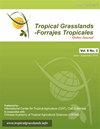海南儋州10种格罗纳牧草产量及营养价值比较
IF 0.7
4区 农林科学
Q3 AGRICULTURE, DAIRY & ANIMAL SCIENCE
引用次数: 0
摘要
热带地区对优质牧草的需求日益增加,可选用营养价值较高的豆科植物格罗娜(Grona)。本研究对2016 - 2018年海南儋州10个格罗纳属牧草材料的饲料产量和营养价值进行了比较。测定产量、株高、存活率、叶茎比及粗蛋白质、粗纤维、粗脂肪(粗脂肪)、无氮浸出物、粗灰分、钙、磷浓度。结果表明,刺棘球孢菌(Grona strigillosa,同属刺棘球孢)对棘球孢菌的致病性有显著影响。热燕27号和异水芹亚种。卵形花序(同名:卵形花序)Maquenque表现最好,其干物质产量分别比对照材料G. heterocarpa subsp.高261.3%和235.6%。ovalifolia简历。2018年排名第16位。品种马昆的成活率高于对照(P<0.05)。关于营养价值,cv。热炎27号的粗脂肪和粗纤维含量高于对照(P<0.05),钙含量低于对照(P<0.05)。基于PCA排序,我们得出cvv。马昆克和热延27号可作为中国热带地区畜牧生产的适宜候选材料。在提出实际建议之前,需要对它们的单宁浓度和动物接受度进行进一步的研究。本文章由计算机程序翻译,如有差异,请以英文原文为准。
Comparison of forage production and nutritive value of 10 Grona spp. accessions in Danzhou, Hainan, China
The demand for high-quality forages is increasing in tropical regions, and could be filled with legume species of the genus Grona, which have good nutritive value. In this study, a comparison of the forage production and nutritive value of 10 accessions of Grona spp. was carried out in the field at Danzhou, Hainan from 2016 to 2018. Yield, plant height, survival rate, leaf:stem ratio and concentrations of crude protein, crude fiber, crude fat (ether extract), nitrogen free extract, crude ash, calcium and phosphorus were measured. Results showed that Grona strigillosa (syn. Desmodium strigillosum) cv. Reyan No. 27 and G. heterocarpa subsp. ovalifolia (syn. Desmodium ovalifolium) cv. Maquenque displayed the best performance, owing to their 261.3% and 235.6% higher dry matter yields, respectively, compared with the Control germplasm, G. heterocarpa subsp. ovalifolia cv. Reyan No. 16 in 2018. Cultivar Maquenque had a higher survival rate than the Control (P<0.05). Regarding nutritive value, cv. Reyan No. 27 exhibited higher crude fat and crude fiber but lower Ca concentrations than the Control (P<0.05). Based on PCA ranking, we concluded that cvv. Maquenque and Reyan No. 27 could be used as suitable candidate materials for livestock production in tropical regions of China. Further studies on their tannin concentrations and their acceptability by animals are needed before practical recommendations can be made.
求助全文
通过发布文献求助,成功后即可免费获取论文全文。
去求助
来源期刊

Tropical Grasslands-Forrajes Tropicales
Agricultural and Biological Sciences-Agronomy and Crop Science
CiteScore
1.60
自引率
0.00%
发文量
36
审稿时长
16 weeks
期刊介绍:
The Journal publishes, in English or Spanish, Research Papers and Short Communications on research and development, as well as contributions from practitioners (Farmer Contributions) and Review Articles, related to pastures and forages in the tropics and subtropics. There is no regional focus; the information published should be of interest to a wide readership, encomprising researchers, academics, students, technicians, development workers and farmers.
In general, the focus of the Journal is more on sown (''improved'') pastures and forages than on rangeland-specific aspects of natural grasslands, but exceptions are possible (e.g. when a submission is relevant for a particularly broad readership in the pasture and forage science community).
The Journal will also consider the occasional publication of associated, but closely related, research in the form of an additional scientific communication platform [e.g. a re-make of the former Genetic Resources Communication series of the former Division of Tropical Crops and Pastures of the Commonwealth Scientific and Industrial Research Organisation (CSIRO), Australia].
Areas of particular interest to the Journal are:
Forage Genetic Resources and Livestock Production[...]
Environmental Functions of Forages[...]
Socio-economic Aspects[...]
Topics within the aforementioned areas may include: Diversity evaluation; Agronomy; Establishment (including fertilization); Management and utilization; Animal production; Nutritive value; Biotic stresses (pests and diseases, weeds); Abiotic stresses (soil fertility, water, temperature); Genetics and breeding; Biogeography and germplasm collections; Seed production; Ecology; Physiology; Rhizobiology (including BNF, BNI, mycorrhizae); Forage conservation; Economics; Multilocational experimentation; Modelling.
 求助内容:
求助内容: 应助结果提醒方式:
应助结果提醒方式:


